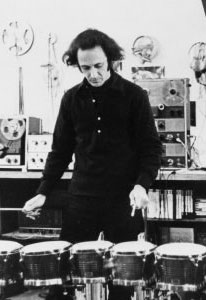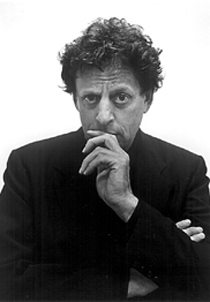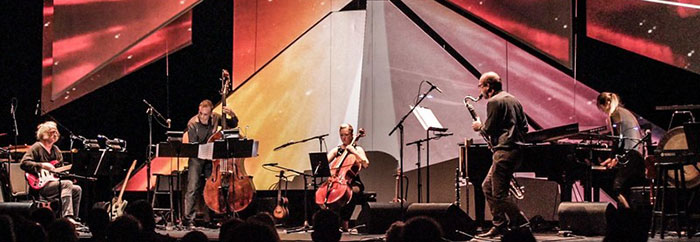
Rhythmic Revolutionaries
Freeing contemporary music from its ivory tower and giving it back to the people.
One of Australia’s most sought-after pianists and educators Leigh Harrold salutes 1960s America for putting the rhythm back into contemporary art music and kickstarting the evolution of the Bang On A Can All-Stars.
Thank you America
We really have America to thank for putting the rhythm back into contemporary art music. When everything we thought we knew about music started to crumble at the beginning of the twentieth-century, part of what it meant to be ‘innovative’ was to rob music of any sort of predictable pulse. From the glorious cacophony that opens Stravinsky’s ‘The Rite of Spring’, to the brain-melting cross-rhythms of Boulezian serialism, toe-tapping slid way down the list of priorities for European composers from about 1915 onwards.

The backlash against all this meticulous unpredictability began on the American West Coast in the 1960s. The early works of the so-called Minimalists – Steve Reich and Philip Glass amongst them – consisted almost solely of predictability. These compositions, which include such masterpieces as Drumming and Music in Similar Motion began as defiant statements about the power of simplicity in the face of complexity. But it’s in their rhythmic strength that they precipitated a revolution.
Viva La [Musical] Revolución
You see, constant repetition creates a regular pulse, which in turn gives us a beat we can toe-tap to. Other American composers embraced the Glass/Reich sensibility and something remarkable happened: whereas the chasm between pop-music and the European avant-garde had never been wider, in the USA the gap actually started to close. For the first time in over 300 years, western art music and commercial pop started to resemble each other.

Enter The All-Stars
As the stylistic boundaries continued to blur, it almost seemed inevitable that a group like the Bang On A Can All-Stars (BOACAS) would emerge – a new type of fearless musician that combined high-art classical precision with the brazenness of a rock-star. What could not have been predicted though, is the ferocity of their vision and their indefatigable commitment which still sees them at the razor’s edge of experimental music-making over 25 years later. This is no cringeworthy Kimmy Schmidt-type ‘Let’s rap to Socrates’ outfit (jump on Netflix immediately if you need clarification). These people know exactly what the kids are doing, and they do it better.
The BOACAS are just one arm of the Bang on a Can juggernaut. The full organisation includes a commissioning fund, social engagement initiatives, and a summer school for aspiring professional musicians. This years’ school has just wrapped-up – unsurprisingly, one of the activities was a competitive game that tested rhythmic precision (it was won by an Australian!).
From The Concert Hall To The Streets
At every level the group is about inclusiveness; about demolishing the divide between the music of the concert hall and the music of the streets. Their very name suggests this. ‘Bang on a Can’ is an invitation ('Make music using anything, loudly!'), while ‘All-Stars’ is a #relatable term in the American vernacular that suggests that anyone – from a baseball-player to a drag-queen – can become a hero if they’re good enough. And the All-Stars are certainly good enough – striving for inclusivity never means compromising on quality.

Virtuosos of the 21st Century
For me, the BOACAS and the composers who write for them have redefined what it means to be a virtuoso in the 21st century. You might not be asked to show off your glittering Lisztian double-octaves on the piano, but there are other challenges: fighting mounting lactic acid build-up during the unrelenting string strokes of Julia Wolfe’s Dig Deep; quickly strapping an accordion to your chest (even though you don’t play accordion) in Michael Gordon’s the light of the dark; minimising the amount of blood left on the clarinet reed while navigating the slap-tongues of David Lang’s Press Release.
But the BOACAS have endured because they know that music being written today should reflect the life all of us are living, in all its grunge and glamour. They have freed contemporary music from its ivory tower and given it back to the people. And for that, the future of art will thank them.
About the Writer: Leigh Harrold

Leigh Harrold has emerged in recent years as “a musician of rare talent and intelligence” (Raymond Chapman Smith) and is one of Australia’s busiest and most sought-after piano players, winning the Adelaide Critics’ Circle prize for Best Emerging Artist of 2005. Born in Whyalla, South Australia, Leigh completed undergraduate and post- graduate studies at The University of Adelaide with concert pianist Gil Sullivan. He moved to Melbourne in 2003 to take up a full scholarship at the Australian National Academy of Music under the mentorship of Geoffrey Tozer and in 2004 was made the Academy Fellow – the first person in the institution’s history to be chosen as such after just one year of study. As a soloist, Leigh has performed with the Adelaide Symphony Orchestra, the Tasmanian Symphony Orchestra and the ANAM Chamber Orchestra and is broadcast regularly on ABC-FM and the MBS radio network. As a chamber musician he has earnt an international reputation, having performed as duo partner with such luminaries as Thomas Reibl, lecturer in viola at the Salzburg Mozarteum; Michael Cox, principal flautist with the BBC Symphony Orchestra; Daniel Gaede, ex-concertmaster of the Vienna Philharmonic Orchestra; Swedish cellist Mats Lidstrom; and British pianist Mark Gasser. Other significant international collaborations have included performance and studies with Andrew Ball at the London Royal College of Music; New York-based pianist Lisa Moore and English composer Peter Maxwell Davies. Leigh also holds two University medals – one for Music and one for Applied Science.

